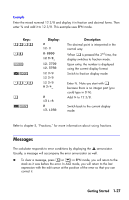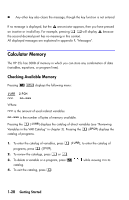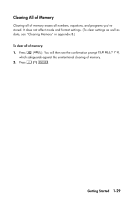HP 35s HP 35s scientific calculator - User Guide - Page 47
RPN: The Automatic Memory Stack, What the Stack Is - programs free
 |
UPC - 000000000000
View all HP 35s manuals
Add to My Manuals
Save this manual to your list of manuals |
Page 47 highlights
2 RPN: The Automatic Memory Stack This chapter explains how calculations take place in the automatic memory stack in RPN mode. You do not need to read and understand this material to use the calculator, but understanding the material will greatly enhance your use of the calculator, especially when programming. In part 2, "Programming", you will learn how the stack can help you to manipulate and organize data for programs. What the Stack Is Automatic storage of intermediate results is the reason that the HP 35s easily processes complex calculations, and does so without parentheses. The key to automatic storage is the automatic, RPN memory stack. HP's operating logic is based on an unambiguous, parentheses-free mathematical logic known as "Polish Notation," developed by the Polish logician Jan Łukasiewicz (1878-1956). While conventional algebraic notation places the operators between the relevant numbers or variables, Łukasiewicz's notation places them before the numbers or variables. For optimal efficiency of the stack, we have modified that notation to specify the operators after the numbers. Hence the term Reverse Polish Notation, or RPN. The stack consists of four storage locations, called registers, which are "stacked" on top of each other. These registers - labeled X, Y, Z, and T - store and manipulate four current numbers. The "oldest" number is stored in the T- (top) register. The stack is the work area for calculations. RPN: The Automatic Memory Stack 2-1















